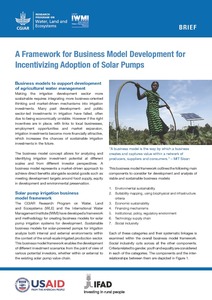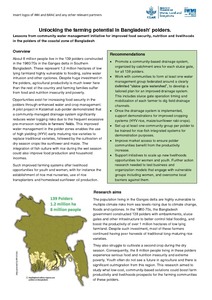Reviving Springs: An eight step methodology
Springs, also called dhara, mool, kuwa, naula, and chasma, are, the most important source of water for millions of people in the midhills of the Hindu Kush Himalayas. Spring water is used for drinking, irrigation, domestic, and religious purposes. They also perform important ecological functions, like supporting local vegetation and wildlife and maintaininng baseflow in rivers. The methodology integrates aspects of physical and social sciences, and is just as useful for researchers as it is for field practitioners.
Unlocking the farming potential in Bangladesh’ polders.
The sustainable land management program in the Ethiopian highlands: An evaluation of its impact on crop production
Agricultural productivity in the highlands of Ethiopia is threatened by severe land degradation, resulting in significant reductions in agricultural GDP. In order to mitigate ongoing erosion and soil nutrient loss in the productive agricultural highlands of the country, the government of Ethiopia initiated a Sustainable Land Management Program (SLMP) targeting 209 woredas (districts) in six regions of the country. This study evaluates the impact of SLMP on the value of agricultural production in select woredas by using a panel survey from 2010 to 2014.
Synopsis: The Sustainable Land Management Program in the Ethiopian highlands: An evaluation of its impact on crop production
Agricultural productivity in Ethiopia’s highlands, the country’s breadbasket, is threatened by severe land degradation. To mitigate ongoing soil erosion and soil nutrient loss, the government of Ethiopia initiated the Sustainable Land Management Program (SLMP). We evaluated the program’s impact on the value of agricultural production in select kebeles (administrative sub-districts) in which it was implemented using a two-round survey of farm households.
Mining water governance : everyday community-mine relationships in the Peruvian Andes
This thesis documents as well as questions how the presence of large mining operations in Andean regions of Peru alters social and natural landscapes. Taking conflicts over water as a useful entry-point for the analysis, it explores and unravels the dilemmas and challenges faced by the main conflicting actors: rural communities and mining companies. Through an in-depth analysis of how the actors navigate these challenges, focusing on those related to water, the thesis sets out to understand what happens with water in contexts of mineral extraction.
Assessing land suitability for aquifer storage and recharge in northern Ghana using remote sensing and GIS multi-criteria decision analysis technique
Increasing climate variability and challenge in access to water pose major impediments to rainfed agricultural productivity. Extensive flooding of agricultural lands during the rainy season and lack of water during the 8-month long dry season affect the livelihood of the people in the northern Ghana, a situation that calls for better water management practices. The use of aquifer storage and recharge (ASR) based technique, helps to reduce flooding and improve access to water during the dry season; however such technology has specific requirements for successful implementation.
Agriculture in the Fertile Crescent: continuity and change under climate change.CAB Reviews
The Fertile Crescent (FC) is a high biodiversity region where most temperate-zone agricultural species originated and were first domesticated. A favourable environment, a special plant community and an adaptive population combined to initiate the transition from a hunter-gatherer economy to one based on agriculture and food production in the Fertile Crescent.
Runoff estimation and estimation of water balance components of Phetchaburi basin using soil and water assessment tool
Agro-climatic and hydrological characterization of selected watersheds in northern Ghana
A regional scale ecological risk framework for environmental flow evaluations
Recent developments in Environmental Flow (E-flow) frameworks advocate holistic, regional scale, probabilistic E-flow assessments that consider flow and non-flow drivers of change in socio-ecological context as best practice. Regional Scale ecological risk assessments of multiple sources, stressors and diverse ecosystems that address multiple social and ecological endpoints, have been undertaken internationally at different spatial scales using the relative-risk model since the mid 1990's.








